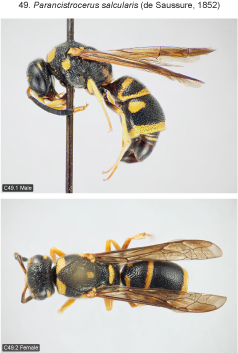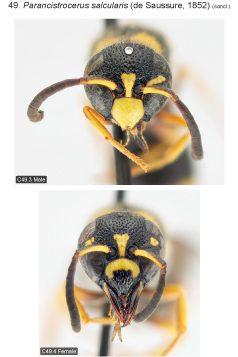
| Home | Table of contents | Keys | Species list | Glossary | Image data | PDF | Cite this article | Feedback | Updates |
Identification Atlas of the Vespidae (Hymenoptera, Aculeata) of the northeastern Nearctic region
CJAI 05, February 19, 2008
doi: 10.3752/cjai.2008.05
Matthias Buck, Stephen A. Marshall, and David K.B. Cheung
Department of Environmental Biology, University of Guelph, Guelph, Ontario, Canada N1G 2W1
Next species | Previous species | Key
49. Parancistrocerus salcularis (de Saussure, 1852)
Figs A4.7–10; B7.26, 27, 49; C49.1–4.

|

|
Species recognition. This species is readily separated from other species by the combination of long hairs on tergum 1 (otherwise only present in P. leionotus, P. bicornis), a distinct transverse carina on tergum 1 followed by a smooth area (absent in P. leionotus), and the absence of interocellar tubercles (present in P. bicornis). Furthermore, P. salcularis has longer hair on the pronotum than other species (length of longest hairs equals basal diameter of flagellomere 1; rarely appearing shorter when large distal portion of hairs is curved posteriorly). Further diagnostic character not mentioned in the key: male flagellum dark beneath; male mid femur without or with a faint anteroventral depression near base; terga 1 and 2 with yellow discal spots; apical margin of tergum 2 very slightly to moderately thickened; apical fascia of tergum 3 usually interrupted.
Variation. Fore wing length 6.0–8.0 mm (♂♂), 8.0–8.5 mm (♀♀). Variation otherwise not studied.
Distribution. Not recorded from Canada. Eastern U.S.: NJ south to FL, west to TX (Krombein 1979). The reddish form from Florida has been named ssp. rufulus (Bohart, 1948).
Biology. All observations are on ssp. rufulus: nests in borings in wood and old galls from scrub oak; nest partitions and closing plugs are made from firmly agglutinated sand. Prey consists of caterpillars of Gelechiidae, Tortricidae, Crambidae (Pyraustinae) and Pyralidae (Phycitinae, Epipaschiinae) (Krombein 1967).
Next species | Previous species | Key
| Home | Table of contents | Keys | Species list | Glossary | Image data | PDF | Cite this article | Feedback | Updates |
